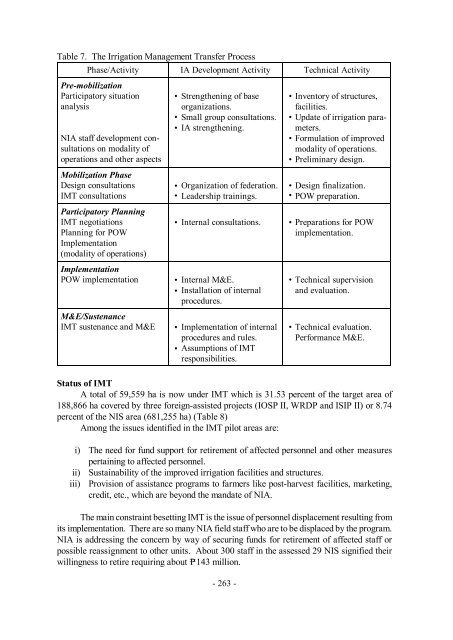Organizational Change for Participatory Irrigation Management
Organizational Change for Participatory Irrigation Management
Organizational Change for Participatory Irrigation Management
You also want an ePaper? Increase the reach of your titles
YUMPU automatically turns print PDFs into web optimized ePapers that Google loves.
Table 7. The <strong>Irrigation</strong> <strong>Management</strong> Transfer Process<br />
Phase/Activity IA Development Activity Technical Activity<br />
Pre-mobilization<br />
<strong>Participatory</strong> situation<br />
analysis<br />
NIA staff development consultations<br />
on modality of<br />
operations and other aspects<br />
Mobilization Phase<br />
Design consultations<br />
IMT consultations<br />
<strong>Participatory</strong> Planning<br />
IMT negotiations<br />
Planning <strong>for</strong> POW<br />
Implementation<br />
(modality of operations)<br />
Strengthening of base<br />
organizations.<br />
Small group consultations.<br />
IA strengthening.<br />
Organization of federation.<br />
Leadership trainings.<br />
Implementation<br />
POW implementation Internal M&E.<br />
Installation of internal<br />
procedures.<br />
- 263 -<br />
Inventory of structures,<br />
facilities.<br />
Update of irrigation parameters.<br />
Formulation of improved<br />
modality of operations.<br />
Preliminary design.<br />
Design finalization.<br />
POW preparation.<br />
Internal consultations. Preparations <strong>for</strong> POW<br />
implementation.<br />
M&E/Sustenance<br />
IMT sustenance and M&E Implementation of internal<br />
procedures and rules.<br />
Assumptions of IMT<br />
responsibilities.<br />
Technical supervision<br />
and evaluation.<br />
Technical evaluation.<br />
Per<strong>for</strong>mance M&E.<br />
Status of IMT<br />
A total of 59,559 ha is now under IMT which is 31.53 percent of the target area of<br />
188,866 ha covered by three <strong>for</strong>eign-assisted projects (IOSP II, WRDP and ISIP II) or 8.74<br />
percent of the NIS area (681,255 ha) (Table 8)<br />
Among the issues identified in the IMT pilot areas are:<br />
i) The need <strong>for</strong> fund support <strong>for</strong> retirement of affected personnel and other measures<br />
pertaining to affected personnel.<br />
ii) Sustainability of the improved irrigation facilities and structures.<br />
iii) Provision of assistance programs to farmers like post-harvest facilities, marketing,<br />
credit, etc., which are beyond the mandate of NIA.<br />
The main constraint besetting IMT is the issue of personnel displacement resulting from<br />
its implementation. There are so many NIA field staff who are to be displaced by the program.<br />
NIA is addressing the concern by way of securing funds <strong>for</strong> retirement of affected staff or<br />
possible reassignment to other units. About 300 staff in the assessed 29 NIS signified their<br />
willingness to retire requiring about P=143 million.
















